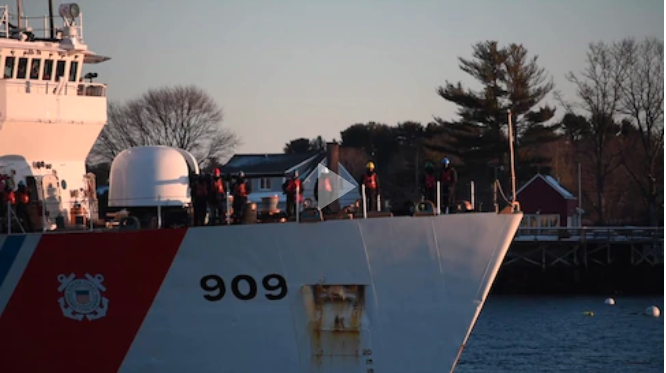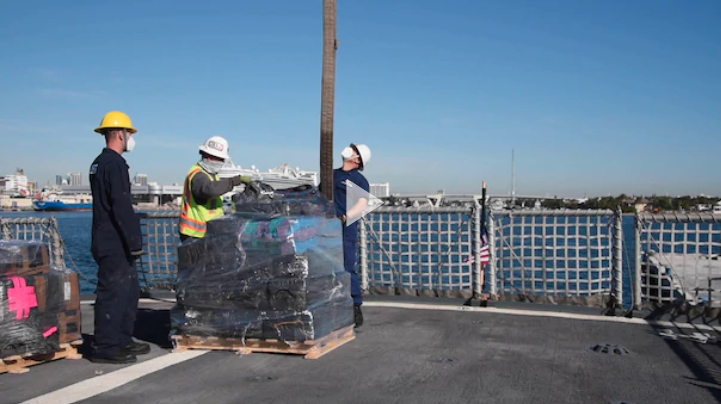PHOTOS, VIDEO AVAILABLE: Kittery, Maine, based USCGC Campbell conducts winter patrol, stops $215 million in cocaine
U.S. Coast Guard sent this bulletin at 02/09/2021 05:15 PM EST
| News Release |
U.S. Coast Guard 1st District Northeast |
Photos, video available: Kittery, Maine, based USCGC Campbell conducts winter patrol, stops $215 million in cocaine
 |
 |
|
 |
 |
 |
![Coast Guard Cutter Campbell offloads more than $97 million in cocaine at Port Everglades [Image 1 of 3]](https://cdn.dvidshub.net/media/thumbs/photos/2102/6509890/360x225_q75.jpg) |
 |
 |
Editors' Note: Click on images to download high resolution version.
BOSTON — The crew of the Coast Guard Cutter Campbell (WMEC 909) returned to Kittery, Maine, on Monday, following a 63-day counter-narcotics patrol in the Eastern Pacific Ocean.
During the patrol, Campbell's crew navigated over 12,000 nautical miles, conducted 122 flight operation evolutions, transited the Panama Canal twice, and crossed the equator into the Southern Hemisphere.
Campbell's successful law enforcement operations interdicted or disrupted over 11,600 pounds of cocaine worth an estimated $215 million and apprehended six suspected international narcotics smugglers.
In transit south to the Panama Canal, Campbell embarked an MH-65 Dolphin helicopter from Helicopter Interdiction Tactical Squadron in Jacksonville, Florida.
During one interdiction, a bridge lookout, using night vision detection, sighted an unlit Low Profile Vessel transiting near the cutter at night. Upon detection, Campbell launched their 26-foot Over the Horizon pursuit boat to intercept the LPV with an embarked law enforcement boarding team.
Campbell's boarding team assumed positive control of the vessel, took aboard three suspected smugglers, and disrupted the delivery of 4,400 pounds of cocaine. The night-time case occurred solely due to the alertness of the bridge lookout.
During another seizure, Campbell vectored toward a second LPV whose crew jettisoned its contraband after being detected by aerial surveillance. Campbell redeployed the Dolphin helicopter team. They stopped the LPV with disabling fire directed into the four outboard engines. Campbell's crew was able to locate and recover the discarded packages, yielding an at-sea weight of 4,415 pounds, and tested positive for cocaine.
Campbell's final case was also detected by aerial surveillance. Campbell again launched the Dolphin helicopter and OTH cutter boat to pursue a 35-foot panga-style "go-fast" vessel traveling at 30 knots with no navigation lights, fuel barrels, and cargo on deck in a known drug trafficking corridor. The Dolphin crew fired warning shots, bringing the vessel to a stop. Campbell retrieved 2,791 pounds of cocaine scrapped before the vessel boarding.
Not all of Campbell's efforts veered toward interdicting narcotics. While patrolling, a crewmember spotted a sea turtle caught in fishing gear, struggling to dive. Campbell launched its OTH pursuit boat, and a team was able to free the Olive Ridley Sea Turtle from the debris.
Throughout the deployment, Campbell worked closely with U.S. Coast Guard and Navy assets on missions in support of Coast Guard’s 11th District, Joint Interagency Task Force South, and more broadly, the Coast Guard's Western Hemisphere strategy to combating drug trafficking organization networks.
"Success during a narcotics patrol requires every member of the collective team to focus on the mission at hand, remain adaptable, and be forward-leaning in executing the mission," said Capt. Thomas Crane, Campbell’s commanding officer. “We have a great team aboard Campbell focused on preventing the flow of illegal narcotics to North America. We were able to accomplish our goal and support the Coast Guard's Western Hemisphere Strategy despite being away from family.”
During at-sea interdictions, the Helicopter Interdiction Tactical Squadron Dolphin helicopter and crew are deployed from the cutter in pursuit of suspect vessels to compel compliance or at times disable a non-compliant vessel's propulsion. In these instances, the HITRON crew will employ airborne use of force with mounted weapons fired from the helicopter.
On April 1, U.S. Southern Command increased counter-narcotics operations in the Western Hemisphere to disrupt the flow of drugs. Numerous U.S. agencies from the Departments of Defense, Justice, and Homeland Security cooperated in the effort to combat transnational organized crime. The Coast Guard, Navy, Customs and Border Protection, FBI, Drug Enforcement Administration, and Immigration and Customs Enforcement, along with allied and international partner agencies, play a role in counter-drug operations.
The fight against drug cartels in the Eastern Pacific Ocean and the Caribbean Sea requires unity of effort in all phases from detection, monitoring and interdictions, to criminal prosecutions for these interdictions by United States Attorney’s Offices from the Middle District of Florida, the Southern District of Florida and the Southern District of California. The law enforcement phase of counter-smuggling operations in the Eastern Pacific Ocean is conducted under the authority of the 11th Coast Guard District, headquartered in Alameda. The interdictions, including the actual boardings, are led and conducted by members of the U.S. Coast Guard.
The Campbell is a 270-foot medium endurance cutter homeported in Kittery.
-USCG-

